John Lindsay’s Unlucky Break
John Lindsay was a classy full-back who suffered injury misfortune that meant he never did get back to the level of fitness and sharpness required for a Blues first team comeback
A successful playing career can be halted in the blink of an eye. John Lindsay (commonly referred to as Jock in the press, but Jack and even Johnny were sometimes used) was a classy full-back who shared in the same injury misfortune while at Everton as Jack Coulter, Eddie Wainwright, Tommy Ring, John Connolly, John Barton, James McCarthy and Andre Gomes, amongst others.
Born on 8 August 1924 in East Dunbartonshire, the full-back joined Glasgow Rangers from Petershill at the end of the Second World War. At 5ft-8½ins of height, and about 11 stone in weight, John was not the most physically imposing of defenders, but his cultured two-footed playing style was complemented by steely determination.
The Ibrox club was blessed with an abundance of full-backs, and John had to play second-fiddle to George Young and Gers skipper ‘Tiger’ Shaw. When Shaw retired, Sammy Cox was converted from a wing-half to a full-back and John saw the prospects of regular first-team football fade. He recalled: “The team was made up of 11 international players. When I stepped in to deputise for either of the full-backs, I was the only man in the side who had no caps… I knew that, as much as I loved it at Ibrox, there was no chance of making it, so I thought it better to be on my way.”
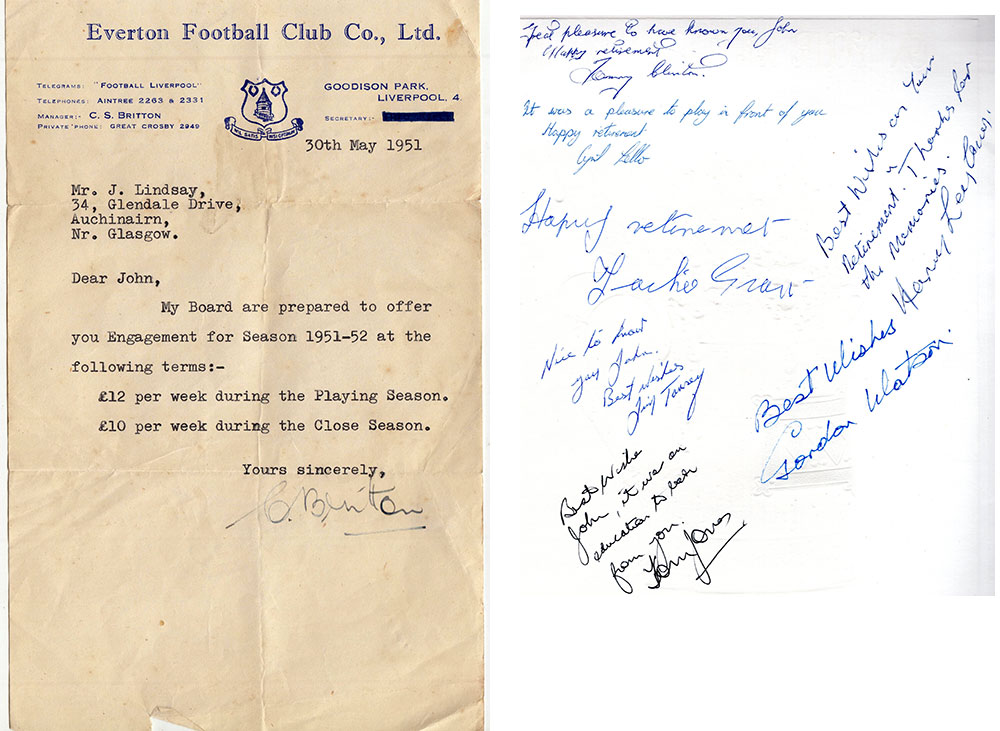
Left: John's terms for the 1951-52 season; Right: Retirement wishes from Everton colleagues in the late 1950s
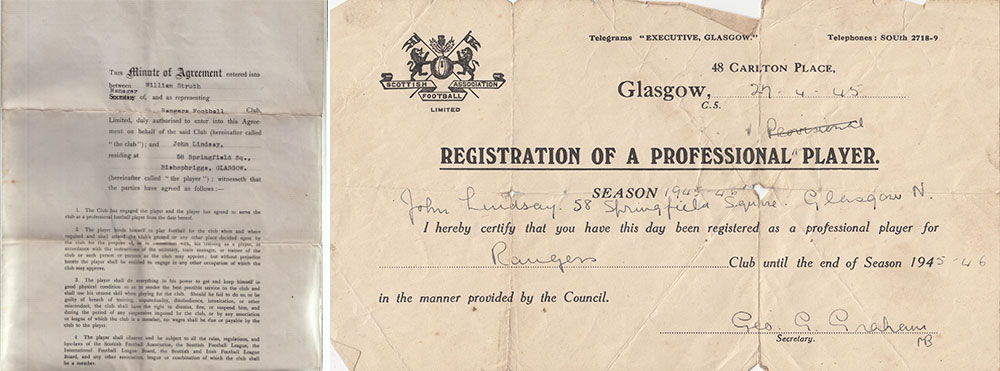
Left: John's contract at Rangers; Johns registration papers with Rangers in 1945
In March 1951, the Glasgow giants accepted a £9,500 bid for John from Everton, who needed a replacement at left-back for National Service-bound George Rankin. The Scot travelled south by train and met his new teammates at Manchester’s Midland Hotel before heading to play in his first match, a 3-0 defeat on a mud-bath of an Old Trafford pitch. The Liverpool Echo reporter wrote: ‘He showed touches that are a good augur for the future’. When interviewed post-match, the debutant stated: ‘English football is much faster, and they do not hold the ball as they do in Scotland.’ A few days later, he made his home debut, up against Stoke’s Stanley Matthews.
Sadly, the new recruit arrived too late to help turn around the Blues' sorry season, which ended in relegation. Nevertheless, he did not regret moving south: ‘I enjoyed my time at Goodison and certainly got the chance to establish myself as a first teamer. I relished playing English football.’ Living in club accommodation at 7 Radnor Drive in Bootle, the new life on Merseyside was a culture shock for his two daughters, Catherine and Janette and homesickness for Bishopbriggs lingered (with summer holidays in Scotland a welcome break). They eventually adjusted, however, and remain on Merseyside, to this day.
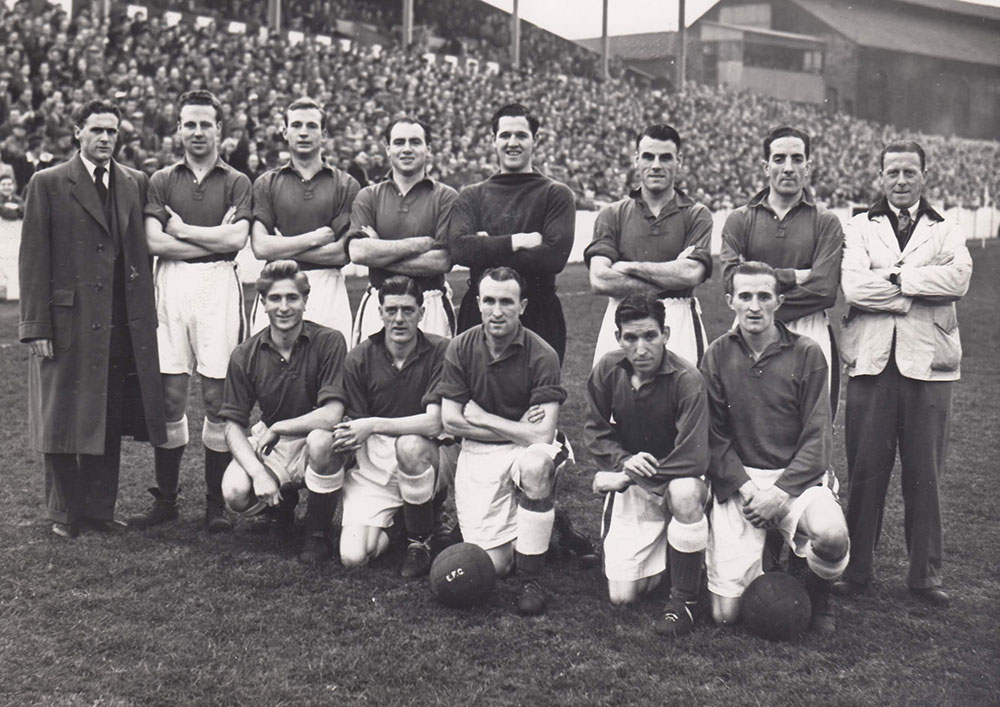
Everton, early 1950s
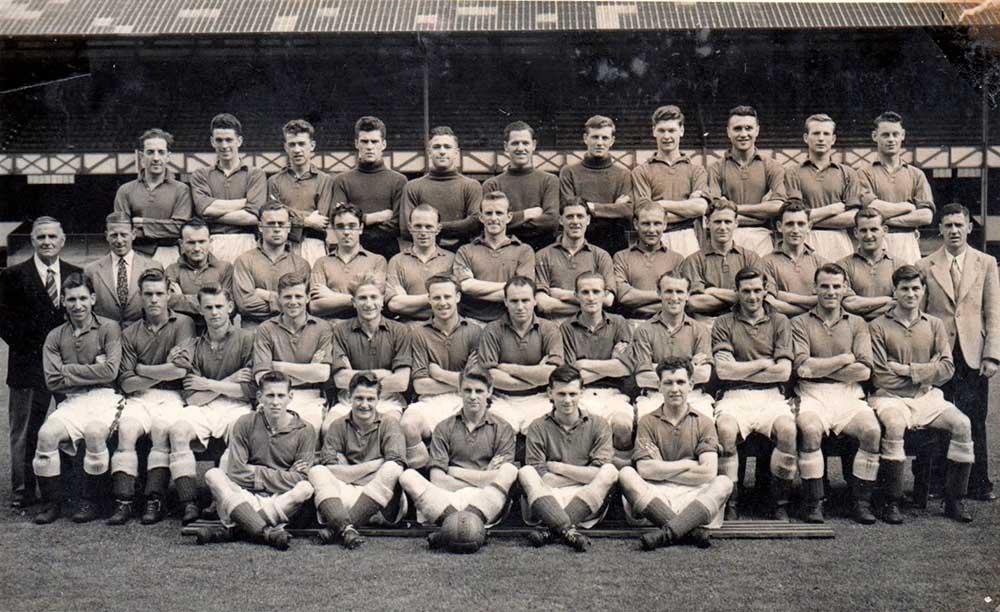
Everton squad circa 1954
John held down the left-back position for virtually the entirety of the club’s three seasons in the Second Division. In the 1953-54 campaign, he played a key role in the push for promotion, accepting the responsibility of penalty kick duties in February, converting successfully on the two occasions he stepped forward.
Alas, on 10 April, with Everton in third position in the table, and pushing for a top-two finish., Jack was stretchered having suffered a compound fracture of his left leg, when making a last-ditch interception to prevent Stoke City from scoring. He had broken a leg while at Rangers, but this was a devastating injury. Stoke City’s directors sent a letter of regret to their Everton counterparts regarding John’s accident.
In his Liverpool Echo column, written after the Toffees secured promotion, club captain Peter Farrell gave praise to his stricken teammate:
‘I know the lads will forgive me if I single out one man who was unable to be with us at the finish. The name, of course, is Jock Lindsay. He paid a tremendous price in his efforts to win promotion, namely a broken leg. But I know that neither supporters nor player will ever forget that great but unfortunate tackle against Stoke which prevented a certain goal. and won us a point which proved so valuable in the final reckoning. Incidentally, Jock has asked me through this column to express his sincere thanks to all those people who brought so much happiness to him while he was in the nursing home, by their messages of good wishes through the post or by calling to visit him.’
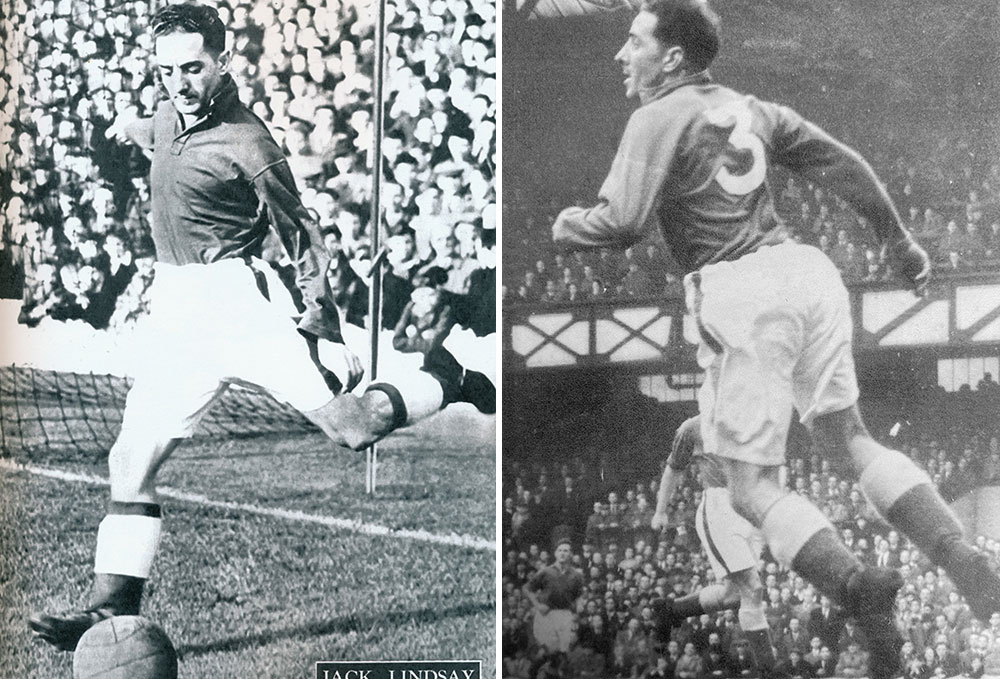
Left: Number three gets airborne; Right: John circa 1953
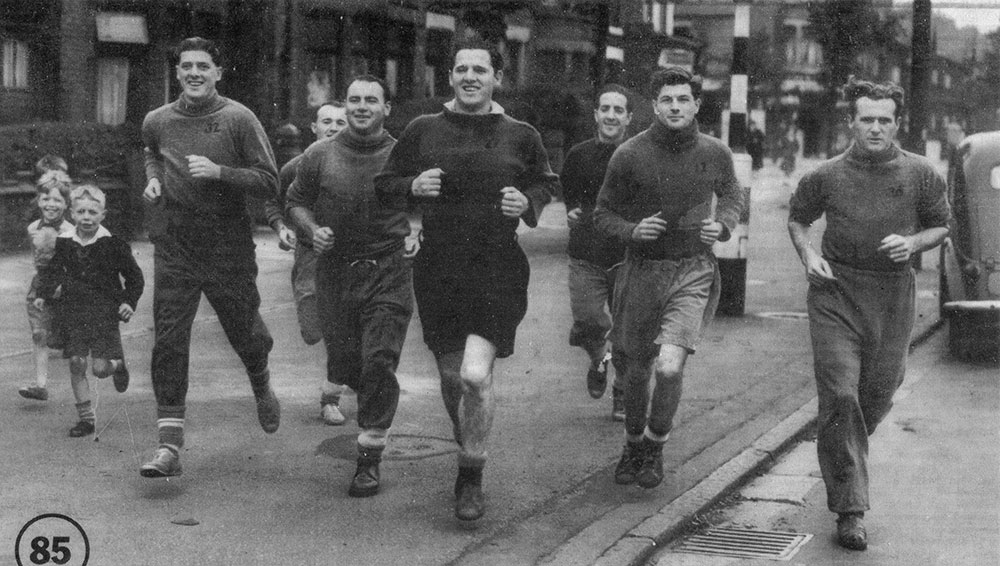
Training in the streets
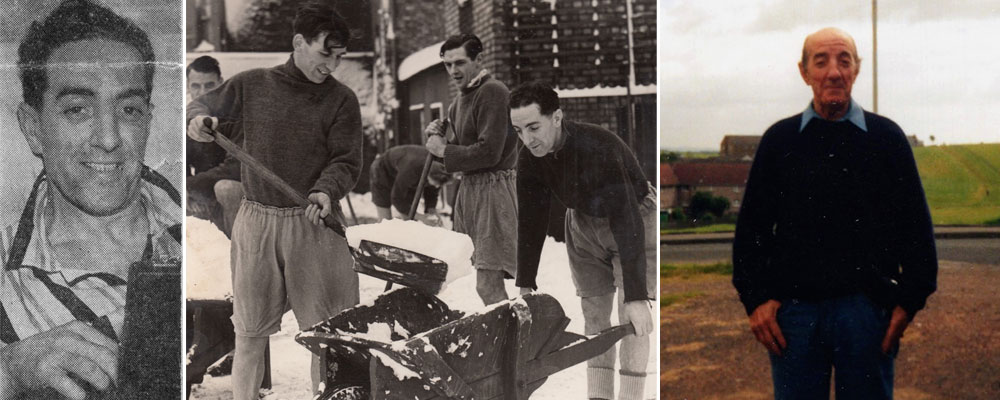
Left: John in hospital after his leg break; Middle: Snow clearance at Goodison Park training ground; John in later life
The local press reported that by mid-August he was making a remarkable recovery, walking with crutches but on the point of switching to sticks. He was attending Goodison Park daily for treatment and there was optimism that he could commence some light training in the not-too-distant future. Mr Heron, the specialist engaged by the club stated: “I have never met a better patient than Jock. He has been a typical example of dour Scottish courage.”
He was back kicking a ball in early 1955 and stepped up to C team duties in early September. According to Peter Farrell, he was going into heavy tackles with no ill effects, but he recognised that fourth team football was a far cry for the First Division. Farrell ended by stating that ‘Jock has the courage and tenacity to make a complete comeback.’
However, the discomfort in his leg did linger, and he had lost some of his mobility. Unsurprisingly, John never did get back to the level of fitness and sharpness required for a Blues first team comeback, in spite of a loan spell at non-League Worcester City. David Exall, a young Worcester supporter who was later Everton’s promotions manager, recalls Jock being a cut above other players in his boyhood team’s first eleven.
Two months after collecting a £750 benefit cheque in June 1956 from Everton director Dick Searle, in recognition of his long service, he departed Goodison. With John Willie Parker, he moved to Bury in a £3,500 deal. A year later, he joined South Liverpool – it was reported that at Holly Park he compensated for his loss of pace with great football intelligence. He was promptly given the captaincy and appears to have played on for up to two seasons at Holly Park.
Then he had a brief spell in Welsh football before calling it a day and walking away from the sport without much of a glance back: ‘I must admit I was getting on a bit, and feeling the pace, so decided to quit. I had never thought about staying in football. I was never any good at watching it. I hated it when I was out of the team and had to go along to the match. I used to slip away before the end.’
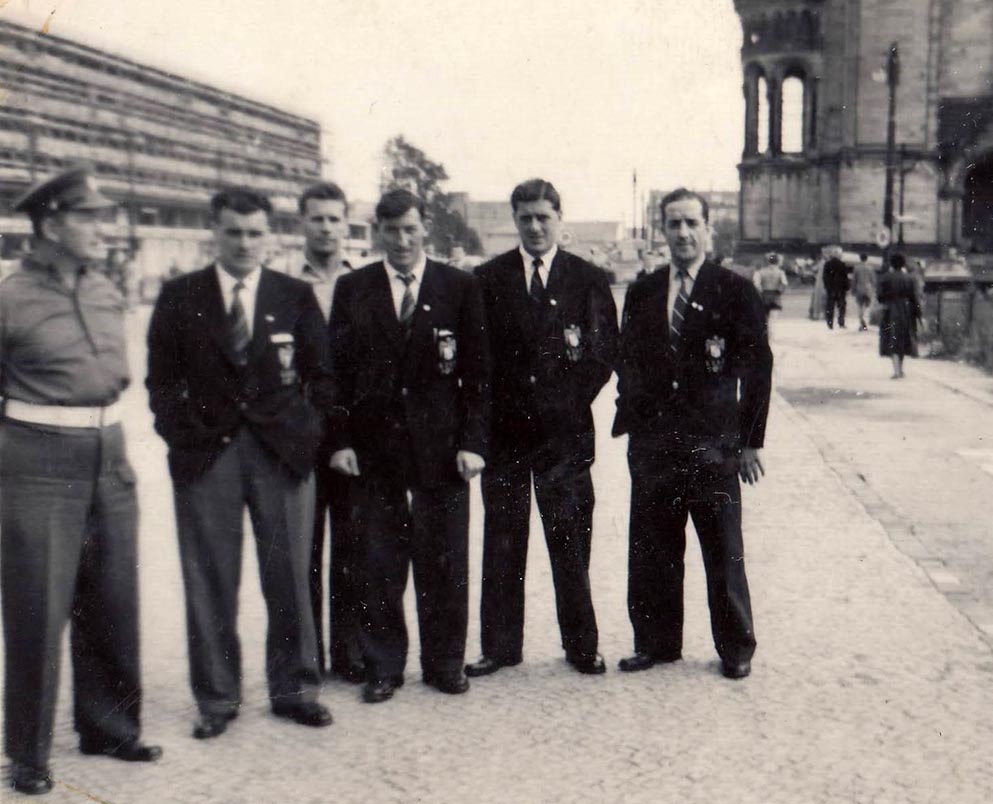
Bury FC players with John Lindsay and John Willie Parker
Although he lost touch with football after hanging up his boots, John would frequently bump into the likes of Tommy Clinton, Alex Stevenson and Billy Cook near his home and would sometimes join them for a drink. He was also invited up to Ibrox for functions, on occasion.
His sporting interest shifted to badminton, which he’d enjoy playing with his family. An attempt at running a high-class taxi service with a used Jaguar that he had purchased proved unsuccessful (he was prone to not charging the many customers that he knew). The former full-back went on to work as a maintenance engineer at Walton Hospital (while on Rangers’ books, he had continued with his engineering apprenticeship). There were no regrets: ‘I really enjoy working at Walton, and I can’t really say I miss football too much.’
When John retired from work at Walton Hospital, Everton sent him a card, signed by the likes of Tommy. G Jones, Cyril Lello, Gordon Watson and Tommy Clinton.
John Lindsay passed away from cancer on 25 November 1991, at the age of 66. A funeral was held at Thornton Crematorium.
Acknowledgement
With thanks to John’s daughters, Janette and Catherine, and granddaughter Sharon, for their help with this article.
Sources
evertonresults.com
bluecorrespondent.co.uk
evertoncollection.org.uk
Reader Responses
Selected thoughts from readersEither no responses have been submitted so far to this article or previous submissions are being assessed for inclusion.
Add Your Thoughts
Only registered users of Evertonia can participate in discussions.
Or Join as Evertonia Member — it takes just a few minutes and will allow you to post your thoughts on artices across the site.

